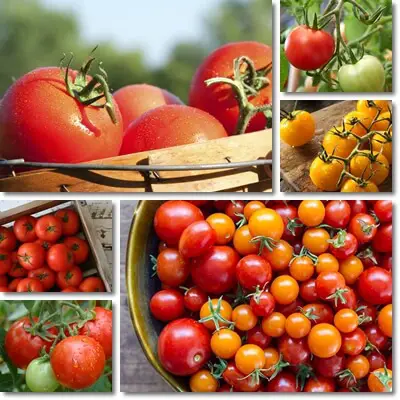Do Tomatoes Raise Blood Sugar?Yes, tomatoes raise blood sugar because they contain digestible carbohydrates. Digestible carbohydrates are broken down into sugar during digestion which is then absorbed into the bloodstream contributing to blood sugar levels, formally known as blood glucose.
But being a low-glycemic food with a GI score of only 15, the rise in blood sugar tomatoes generate is overall modest.
Not just this, but tomatoes produce a steady and gradual rather than instant rise in blood sugar levels.
This means that the limited amount of sugar you do get from eating tomatoes is absorbed at a steady rate, little by little so the body has time to move it out of the bloodstream and into cells that process it and thus does not accumulate creating an unhealthy state of hyperglycemia.

But the biggest question is: can diabetics eat tomatoes? Tomatoes are ok for diabetics to eat only if they are consumed in reasonable amounts, according to the diabetic person’s individual nutritional requirements.
An excessive intake will most likely cause sugar to accumulate in the bloodstream and the diabetic body, unable to produce enough insulin to move it out (sometimes none), will become overwhelmed and suffer the side effects.
Even if a food is low glycemic and should have minimal effects on blood sugar as a result, an excessive intake trumps the benefits of a low glycemic index score and initiates a plethora of side effects for the diabetic patient.
Some foods like tomatoes have very little fiber which is an indigestible carbohydrate that slows down the digestion process and the emptying of the stomach which further tempers the rise in blood sugar, resulting in reduced effects on blood sugar. Making sure you eat your tomatoes with skin and seeds ensures you get what little fiber there is in the culinary vegetable which, together with the limited content of carbs, makes tomatoes a relatively safe food to eat for high blood sugar.
How much dietary fiber in tomatoes?
The different cultivars of tomato vary significantly in their makeup: there are tomatoes with more seeds than actual pulp and tomatoes with almost no seeds, tomatoes with a thick peel and tomatoes with a very thin peel, tomatoes with more juice than actual pulp and tomatoes with a thick, meaty pulp and barely any juice. The range in makeup drives sometimes measurable nutritional differences such as, for example, differences in fiber content.
Tomatoes that are meaty, full of seeds or have a thick peel have more fiber than tomatoes that are seedless or have more juice than actual pulp. But to give you a fairly general idea of how much fiber there is in tomatoes, know that there usually is a little over 1 gram of dietary fiber per 100 grams of raw, unprocessed tomato.

How much protein and fat in tomatoes?
Tomatoes are low in carbs and fiber, but they are also extremely low in protein and fat. A serving of just 100 grams of raw, unprocessed tomato has less than 1% protein and about 0.2% fat. When you have high blood sugar, it helps to eat more lean protein and small amounts of fat to better help with blood sugar control. But if high blood sugar is joined by excess weight, then it helps to also lower your intake of fat and your intake of protein from foods that are also high in fat.
Tomatoes sort of meet the bulk of requirements for foods that are good to eat for high blood sugar and blood sugar control: while they aren’t a good source of lean protein, they are low in carbs and sugar, low in fat and low in calories, and provide some dietary fiber. If consumed reasonably, they are one of those foods that actively help with achieving good blood sugar control.
More about fat and protein and blood sugar
Fat and protein are two essential (macro)nutrients that play an important part in blood sugar control. For one, fat and protein do not contribute to blood sugar levels measurably: while digestible carbs are broken down into simple sugars, their most simple constituents, fat and protein are broken down into fatty acids and amino acids and, as a result, bring no contribution to blood sugar levels.
Not just this, but both fat and protein help slow down digestion and the rate of sugar absorption into the bloodstream, essentially lowering the glycemic effects of food. Small amounts of healthy fats such as cold pressed vegetable oils or fruits and vegetables that are naturally high in fat paired with lean protein are important for healthy blood sugar levels.
Tomatoes glycemic index and glycemic effects
The particular nutritional makeup of tomatoes is what contributes to their low glycemic index score. What is the glycemic index? The glycemic index (abbreviated as GI) is a scale estimating the effects of different foods on blood sugar levels. Between 0 and 55 is a low glycemic index score. Between 56 and 69 is a moderate glycemic index score. Between 70 and 100 is a high glycemic index score.
The lower the GI score of a food, the lower its effects on blood sugar and the better it is for blood sugar control. Tomatoes on the glycemic index hold a score of about 15, an average value that applies to all cultivated varieties of the ripe fruit. This means they are very low glycemic and a good food to consider eating if you have diabetes or hyperglycemia. Find out more about the glycemic index of tomatoes.
The reason for the low glycemic impact of tomatoes is their nutritional makeup. For one, tomatoes are about 94-95% water. Just as important, they are also quite low in digestible carbohydrates, including simple sugars. What this means there isn’t much to fuel a rise in blood sugar hence the reason why you can actually eat tomatoes even with diabetes, and do so safely.
How many carbs and sugar in a tomato?
Values assigned to different varieties of red ripe tomatoes:
- one Roma or Italian plum at around 62 grams has 2.41 grams of carbs of which 1.63 grams are sugars
- one cherry tomato at only 17 grams has 0.66 grams of carbohydrates of which 0.45 grams are sugars
- one cup of cherry tomatoes weighing an estimated of 149 grams has 5.8 grams of carbs of which 3.92 grams are sugars
- one large fruit with an estimated weight of 182 grams provides 7.08 grams of carbohydrates of which 4.79 grams are sugars
- one medium fruit weighing 123 g provides 4.78 grams of carbohydrates and 3.23 grams of sugars
- one small fruit at about 91 grams has 3.54 grams of carbs of which 2.39 grams are sugars
Some varieties are higher in carbohydrates and sugar than others. For example:
- 100 grams of red tomatoes has an average of 3.89 grams of total carbs of which 2.93 grams sugars
- 100 grams of green varieties has 5.1 grams of carbs of which 4 grams are sugars
- 100 grams of orange varieties has 3.18 grams of carbs
- 100 grams of yellow varieties has 2.98 grams of carbs
Nutritional information of tomatoes courtesy of USDA.gov.
How many tomatoes can you eat if you have diabetes?
How much of a food you can eat safely if you have diabetes is something each diabetic person has to determine for themselves. Individual intakes of certain foods are best assessed according to several factors including nutritional value of the food, current weight and state of health, level of physical activity, individual nutritional requirements and dietary restrictions.
Generally, foods that are low on the glycemic index such as tomatoes whose GI score is just 15 can be eaten safely with diabetes, but intake is best kept reasonable.
If you are unsure of how much tomato you can actually eat with your condition or fear even a standard serving size may affect your blood sugar too much, you can start off with small amounts of the likes of 1 medium tomato (estimated weight: 123 grams) or 1-2 Italian plum or Roma tomatoes (estimated weight per fruit: 62 grams). Notice your reactions, check your blood sugar and work your way from there.
It’s important to understand that not everyone reacts the same way to the same food or the same amounts of a food, which is perfectly normal. As a diabetic, you need to adjust intakes of various foods to suit you and enjoy better control of your condition and if that means eating less of something or even avoiding some foods completely, then it’s just what you may need to do.
6 Tips to reduce tomatoes effects on blood sugar
Below you can find some useful tips on how to further reduce the glycemic effects of tomatoes:
- Eat a small portion size. Eating less gets you less carbs per portion which means the effects on blood sugar will be lower.
- Don’t eat the same food every single day. If you feel tomatoes aren’t that good for you, then it might help to not eat them every single day.
- Eat your tomatoes raw, with skin and seeds. This way you get all the fiber you can get from tomatoes which limits the glycemic impact and helps with better blood sugar control.
- Never on an empty stomach or separate from other foods or with other fruits. Eating tomatoes during a meal that also contains lean protein and/or some fat helps to reduce their glycemic effects.
- Pair your fruit wisely by planning your meals ahead of time. Instead of having just tomatoes, it’s actually better to have tomatoes with some leafy greens, chicken, fish, nuts (walnuts, pecans, almonds, cashews, peanuts), seeds (sunflower, pumpkin seeds), peanut butter, avocado, eggs or cheese. The fat and protein from these other foods will help with better blood sugar control.
- Exercise after eating. Or just be active. Studies show physical exercise after eating not only helps lower blood sugar, but also improves glucose tolerance and insulin sensitivity. Not to mention it helps use up all the carbs that went it which is great for avoiding weight gain.
